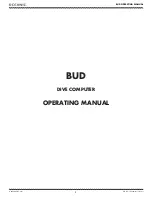
SUBJECT TO CHANGE WITHOUT PRIOR NOTICE
3
Store out of the reach of children.
Pay attention to sharp edges in the threads, flanges and measuring tube. Therefore, it is recommended to wear protective gloves.
The device shall be used in such a way as to minimize the potential for human contact during normal operation. To avoid the
possibility of exceeding radio frequency exposure limits, human proximity to receivers with integrated antenna should not be less than
20 cm (8 inches) during normal operation.
Do not expose the meter to the sun and heat sources. Do not attempt to burn the device.
In case of danger of frost, empty the system and, if necessary, remove the meter.
To clean the device externally use a soft cloth and moistened with water. Do not wash with high-pressure jets or soak the device in
water. Avoid contact with oils and solvent. Do not use alcohol or detergents.
Do not damage the casing of the device. In the event of collisions of blunt objects on the front of the display, it can be irreparably
damaged and lose the IP65 degree of protection. Install in areas protected against impacts. If the protective casing breaks, contact
customer service.
The display turns off. To activate it, press the button on the device. The display remains active for 60 seconds.
The meter is not suitable for drinking water but is suitable for circulating water in central heating systems. The quality of the water
has to be as specified by the CEN/TR 16911 regulation.
Do not twist, wrap, extend or shorten the cables of the temperature probes and the cable that connects the electronic unit to the part
of the lower-case body.
The thermal energy meter can be installed only in areas protected from frost.
The thermal energy meter must be protected against pressure shocks in the pipeline.
Slowly fill the pipe with water at the end of the installation.
After installing the meter perform a leak test of the system.
Assemble or disassemble the meter only after depressurization of the system.
The meter does not have lightning protection.
The meter does not require special protection against electrical interference; however, electromagnetic interference must be avoided.
If transmission network interfaces are used, especially when cables are routed outside the building, use increased protection against
electrical interference.
Rinse the pipes thoroughly before installing the meter.
The device must be installed pay attention to matching the direction of the arrow on the meter brass body to the direction of the flow.
Avoid collecting air bubbles in the meter during the installation process.
The thermal energy meter must not be subjected to mechanical stress when installed in the pipeline.
The meter must be installed in such a way as to be protected from all impurities and external contamination.
Manually and simultaneously screw the device fittings on both sides, and then tighten in opposite directions using a suitable tool.
Remove old seals and clean the sealing surfaces.
Slightly grease the sealing surfaces (use grease approved by MID Standards).
Mount only the newly supplied gaskets (gaskets should not get in the pipeline). Seals provided on site must be fit for purpose and
comply with local guidelines and directives. B METERS disclaim all liability for consequential damage resulting from the use of third-
party gaskets, such as corrosion of sealing surfaces and threads.
Steps for troubleshooting
Problem
Cause
Solution
Display off, does not respond to input
The battery may be damaged or discharged
Inform Customer Service
Damaged brass case or leakage
Possible external impact or fall
Lower body separated by electronic unit
Tampering by third party or strong impacts
Open and visible electronic unit
Tampering by third party or strong impacts




































